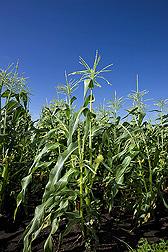Sweet Corn Weed-Management Systems
for the Changing Climate
|
|
Can you imagine a world without sweet corn—the variety of corn we humans enjoy eating the most? Summer barbecues wouldn’t be the same if ears of fresh, sweet corn on the cob weren’t on the menu. And let’s not forget the many recipes that use canned or frozen sweet corn. Served with other ingredients or on its own, sweet corn is one of America’s favorite vegetables.
Thanks to ecologist Marty Williams, we won’t have to worry about forgoing a helping of this tasty treat anytime soon. Williams is working hard to help improve sweet corn production by examining the ecological factors farmers face in growing this popular food crop. He works in the ARS Global Change and Photosynthesis Research Unit in Urbana, Illinois—right in the heart of our country’s Corn Belt.
In a recent study published in Field Crops Research, Williams and colleagues examined how the changing climate is affecting weed growth in corn fields. As the climate in the Midwest gets warmer, weeds commonly seen in the South are now moving north. Changing environmental conditions, such as warmer temperatures and periods of both drought and flooding, are bound to affect corn’s growth and productivity, too.
The researchers examined 175 commercial sweet corn fields throughout the north central United States, a major sweet corn processing region. They sought to identify the important weed species commonly found in these fields and learn more about which management practices are and aren’t working well.
The study produced some interesting results. “The highest yielding fields were those that received tillage between crop rows,” says Williams. “Fields located in the northern part of the region and fields that were planted to a sweet corn hybrid that matured in less than 84 days also produced higher yields.”
The researchers also identified several characteristics of more sustainable weed-management systems. Adequate rainfall or irrigation improved the effectiveness of herbicides, and fields in the northern part of the region experienced lower weed interference and produced fewer weed seeds. While corn yields were related to the amount of weed pressure, the impact of weed pressure on yields depended on planting date. For example, weedy fields yielded more corn when planted in June or July, while less weedy fields had better crop yields when planted earlier.
Surprisingly, the research team found that fields receiving the most expensive weed-control programs and highest rates of herbicide also had the highest weed interference and weed seed production. This shows that even the most rigorous herbicide program doesn’t routinely provide complete control, underscoring the importance of taking a long-term approach to managing the weed seed bank in the soil.
“The fact that latitude showed up repeatedly as an important descriptor of successful production systems and that environmental conditions in the region are changing suggests that best management practices are a moving target,” says Williams. “Our findings show the areas where growers may want to consider changes to their production systems.”—By Stephanie Yao, Agricultural Research Service Information Staff.
This research is part of Crop Protection and Quarantine, an ARS national program (#304) described at www.nps.ars.usda.gov.
Marty Williams is in the USDA-ARS Global Change and Photosynthesis Research Unit, 1102 S. Goodwin Ave., Room N-325, Urbana, IL 61801; (217) 244-5476.
"Sweet Corn Weed-Management Systems for the Changing Climate" was published in the September 2010 issue of Agricultural Research magazine.







